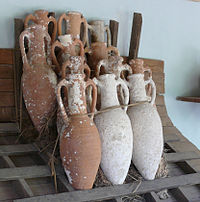
Photo from wikipedia
Abstract This paper presents the study of two sets of Late Iron Age amphorae from the south western Iberian Peninsula through petrographic and Neutron Activation analysis. The first assemblage includes… Click to show full abstract
Abstract This paper presents the study of two sets of Late Iron Age amphorae from the south western Iberian Peninsula through petrographic and Neutron Activation analysis. The first assemblage includes Turdetanian amphorae from the Guadalquivir Valley, studied in relation to nearby production centres. The second group comprises similar amphorae from consumption centres located along the Portuguese coast, whose fabrics have suggested both the import of Turdetanian containers and local production in workshops around the Tagus and Sado estuaries. This study demonstrates the existence of commercial exchange involving foodstuffs between the lower Guadalquivir Valley and the central coast of Portugal. Furthermore, it represents the first petrographic and chemical characterisation of this type of amphora produced around the rivers Sado and Tagus.
Journal Title: Journal of Archaeological Science: Reports
Year Published: 2020
Link to full text (if available)
Share on Social Media: Sign Up to like & get
recommendations!